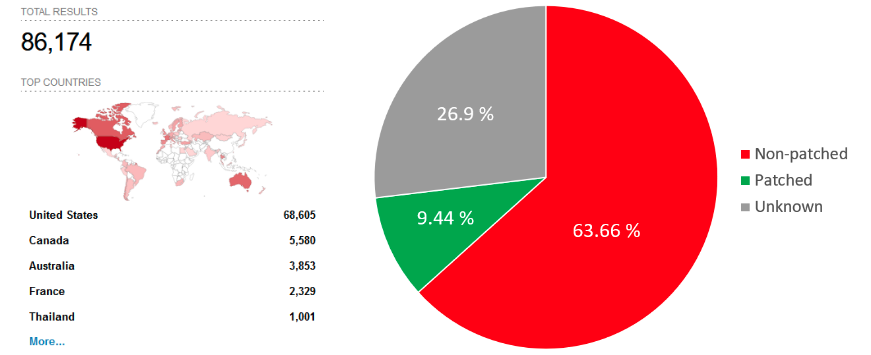
Sierra Wireless Routers Vulnerable to Cyber Attacks
Sierra Wireless routers are vulnerable to cyber attacks – a fact that should send shivers down the spine of anyone relying on them for secure connectivity. This isn’t just some theoretical threat; we’re talking about real-world exploits that can leave your network wide open to malicious actors. Think compromised data, disrupted services, and potentially devastating financial losses. This post dives deep into the vulnerabilities, attack methods, and crucial security measures you need to know to protect yourself.
We’ll explore the common weaknesses found in Sierra Wireless routers, detailing how hackers exploit them and the devastating consequences that can follow. From understanding the attack vectors to implementing robust security protocols, we’ll equip you with the knowledge to safeguard your network. We’ll also examine real-world case studies, offering valuable lessons learned from past incidents. By the end, you’ll have a clear understanding of the risks and the steps you can take to mitigate them.
Sierra Wireless Router Vulnerabilities

Sierra Wireless routers, while popular for their reliability and features, are not immune to cyberattacks. Like any internet-connected device, they possess vulnerabilities that malicious actors can exploit to gain unauthorized access and potentially compromise sensitive data or disrupt services. Understanding these vulnerabilities is crucial for securing networks and mitigating risks.
Common Vulnerabilities in Sierra Wireless Routers
Several common vulnerabilities plague Sierra Wireless routers, often stemming from outdated firmware, weak default passwords, and insecure configurations. These include, but are not limited to, command injection vulnerabilities, cross-site scripting (XSS) flaws, and insecure remote management interfaces. Exploiting these weaknesses can lead to serious consequences for both individuals and organizations.
Potential Impact of Vulnerabilities
The impact of successful exploitation of vulnerabilities in Sierra Wireless routers can be far-reaching. Attackers might gain complete control of the router, allowing them to intercept and manipulate network traffic, steal sensitive data such as login credentials and personal information, launch further attacks against other devices on the network (e.g., through man-in-the-middle attacks), or even use the router as a launching point for broader attacks (e.g., distributed denial-of-service attacks).
This could lead to significant financial losses, reputational damage, and legal repercussions.
Real-World Exploits Targeting Sierra Wireless Routers, Sierra wireless routers are vulnerable to cyber attacks
While specific details of exploits are often kept confidential for security reasons, numerous reports detail successful attacks against Sierra Wireless routers. For example, in some instances, attackers have leveraged known vulnerabilities in the router’s firmware to gain root access, allowing them to install malware, redirect network traffic, and perform other malicious activities. Other attacks have focused on exploiting weak default passwords or insecure remote management interfaces to gain control of the device.
These attacks highlight the critical need for robust security practices and regular updates.
Vulnerability Severity and Consequences
| Vulnerability Type | Severity | Potential Consequences | Example |
|---|---|---|---|
| Command Injection | Critical | Complete compromise of the router, allowing arbitrary code execution. | An attacker injecting malicious commands through a vulnerable web interface. |
| Cross-Site Scripting (XSS) | High | Compromise of user sessions, data theft, and potential redirection to malicious websites. | An attacker injecting malicious JavaScript code into a web page displayed by the router. |
| Weak Default Credentials | High | Unauthorized access to the router’s configuration and network. | An attacker using default credentials to log into the router’s administration interface. |
| Insecure Remote Management Interface | Medium | Unauthorized access to the router’s configuration from remote locations. | An attacker accessing the router’s management interface over an unencrypted connection. |
Attack Vectors and Methods
Sierra Wireless routers, while offering convenient network connectivity, are unfortunately susceptible to various attack vectors. Understanding these attack vectors and the methods employed by malicious actors is crucial for bolstering the security of these devices and preventing unauthorized access. This section details common attack methods, categorized by vulnerability type, to provide a comprehensive overview of potential threats.
Default Credentials and Weak Passwords
Attackers frequently exploit the use of default or easily guessable passwords. Many users fail to change the default administrator credentials upon initial setup, providing an immediate entry point for malicious actors. This simple oversight renders the router vulnerable to brute-force attacks, where attackers systematically try various password combinations until they gain access. Sophisticated attackers may also leverage password cracking tools that utilize dictionaries and other techniques to quickly identify weak passwords.
The consequences of using default credentials can range from simple network intrusion to complete device compromise, allowing attackers to control network traffic and potentially steal sensitive data.
Software Vulnerabilities
Outdated firmware and unpatched software vulnerabilities represent significant attack vectors. Sierra Wireless routers, like any other software-based device, are susceptible to software bugs that can be exploited by malicious actors. These vulnerabilities might allow for remote code execution, giving attackers complete control over the router. Attackers actively scan for and exploit these vulnerabilities using automated tools that identify known weaknesses and attempt to exploit them.
A successful exploit could allow attackers to install malware, redirect network traffic, or even use the router as a launchpad for further attacks on other devices within the network.
- Remote Code Execution (RCE): Exploiting vulnerabilities in the router’s software to execute arbitrary code, giving the attacker complete control.
- Denial of Service (DoS): Overloading the router with traffic, rendering it inaccessible to legitimate users.
- Cross-Site Scripting (XSS): Injecting malicious scripts into the router’s web interface, potentially stealing credentials or compromising other devices.
Network-Based Attacks
Attackers can leverage various network-based attacks to compromise Sierra Wireless routers. These attacks often exploit vulnerabilities in the router’s network protocols or configurations.
- Man-in-the-Middle (MitM) Attacks: Intercepting communication between the router and other devices to steal data or inject malicious code.
- SQL Injection: Exploiting vulnerabilities in the router’s database management system to gain unauthorized access.
- Session Hijacking: Stealing a valid user session to gain access to the router’s administrative interface.
Physical Access
While less common, physical access to the router provides attackers with significant opportunities for compromise. This allows them to directly manipulate the device, potentially bypassing security measures implemented through software or network protocols. For instance, an attacker could simply reset the router to factory settings, effectively erasing any security configurations and gaining immediate access. They could also install malicious firmware or hardware, leading to persistent compromise.
Security Best Practices and Mitigation Strategies
Securing your Sierra Wireless router is crucial to protecting your network and data from unauthorized access and cyberattacks. This section details best practices and provides a step-by-step guide to fortify your router’s security. Implementing these strategies will significantly reduce your vulnerability to common exploits. Remember that security is an ongoing process, requiring regular updates and vigilance.
Effective security relies on a multi-layered approach, combining robust hardware, strong passwords, and regular software updates. Neglecting any of these elements weakens the overall security posture of your network.
Strong Passwords and Regular Password Changes
Strong passwords are the first line of defense against unauthorized access. A strong password is long (at least 12 characters), complex (combining uppercase and lowercase letters, numbers, and symbols), and unique to each device. Avoid using easily guessable passwords like “password” or “123456”. Consider using a password manager to generate and securely store complex passwords. Furthermore, passwords should be changed regularly, at least every three months, to mitigate the risk of compromise.
The use of default passwords should be avoided at all costs.
Firmware Updates and Patch Management
Sierra Wireless regularly releases firmware updates that address security vulnerabilities. Keeping your router’s firmware updated is essential to patching known weaknesses and preventing attackers from exploiting them. Check the Sierra Wireless website regularly for updates and follow their instructions for updating your router’s firmware. Failing to update exposes your router to known vulnerabilities. For example, a known vulnerability in an older firmware version might allow remote code execution, giving an attacker complete control over your network.
Secure Network Configuration
Properly configuring your router’s network settings is critical for security. This includes disabling unnecessary services, such as WPS (Wi-Fi Protected Setup), which can be easily exploited. Consider using a strong encryption protocol like WPA3 for your Wi-Fi network. WPA2, while still better than no encryption, is less secure than WPA3 and should be avoided if possible. Also, change the default SSID (network name) to something unique and less easily guessable.
Access Control and User Management
Limit access to your router’s administration interface to authorized users only. Change the default administrator username and password immediately upon initial setup. Avoid using default credentials. Implement strong authentication methods like multi-factor authentication (MFA) if available. This adds an extra layer of security, requiring more than just a password to access the router.
Regularly review the list of authorized users and remove any accounts that are no longer needed.
Security Checklist
This checklist summarizes the key security measures to implement for your Sierra Wireless router:
- Change default administrator password to a strong, unique password.
- Enable WPA3 encryption for your Wi-Fi network.
- Disable WPS (Wi-Fi Protected Setup).
- Change the default SSID (network name).
- Keep your router’s firmware updated.
- Regularly review and update user accounts.
- Enable firewall features on the router.
- Consider using a VPN for added security, especially when connecting to public Wi-Fi.
- Regularly monitor your router’s logs for suspicious activity.
Impact and Consequences of Attacks

Compromised Sierra Wireless routers can lead to a cascade of serious consequences, impacting individuals, businesses, and even critical infrastructure. The severity of the impact depends heavily on the specific vulnerabilities exploited, the attacker’s goals, and the security measures in place. Understanding these potential consequences is crucial for effective mitigation and risk management.The consequences of a successful cyberattack extend far beyond simple inconvenience.
Data breaches, service disruptions, and financial losses are all real possibilities, and the ripple effects can be devastating. This section will explore the potential impacts on data confidentiality, integrity, and availability, along with the broader financial and reputational repercussions.
Data Confidentiality, Integrity, and Availability
A successful attack on a Sierra Wireless router can severely compromise the CIA triad – Confidentiality, Integrity, and Availability – of data passing through or stored on the network. Confidentiality is breached when sensitive data, such as personal information, financial records, or intellectual property, is accessed and potentially exfiltrated by attackers. Integrity is compromised when data is altered or deleted, leading to inaccurate or unusable information.
Availability is impacted when the router is rendered inoperable, disrupting network access and services for connected devices. For example, a successful denial-of-service (DoS) attack could cripple a small business’s internet connectivity, halting operations and potentially leading to significant financial losses. Similarly, a data breach exposing customer credit card information could result in substantial financial and legal liabilities.
Financial and Reputational Damage
The financial consequences of a successful attack can be substantial. Costs associated with incident response, legal fees, regulatory fines, and remediation efforts can quickly mount. Furthermore, loss of revenue due to service disruption and reputational damage can have long-term effects. Consider a hypothetical scenario involving a large retail chain using Sierra Wireless routers to manage its point-of-sale systems.
A successful attack leading to a data breach could expose customer credit card information, resulting in millions of dollars in fines, legal fees, and the loss of customer trust. The resulting reputational damage could severely impact future sales and profitability.
Hypothetical Scenarios
Let’s examine a few hypothetical scenarios illustrating the varied impact levels:
Scenario 1: Low Severity – Unauthorized Access
An attacker gains unauthorized access to the router’s administrative interface, potentially changing settings like the Wi-Fi password. The impact is limited to inconvenience for legitimate users needing to reset their passwords. Financial and reputational damage is minimal.
Scenario 2: Medium Severity – Data Breach
An attacker exploits a vulnerability to access and exfiltrate sensitive data stored on devices connected to the compromised router. This could involve customer data, financial records, or intellectual property. The impact includes financial losses due to potential legal action and reputational damage from loss of customer trust.
Scenario 3: High Severity – Network Disruption
A sophisticated attack disables the router, causing a significant service outage for a critical infrastructure provider, such as a hospital or power grid. The consequences include massive financial losses, potential loss of life, and severe reputational damage. This scenario highlights the potentially catastrophic impact of compromised routers in sensitive environments.
Case Studies and Real-World Examples

Unfortunately, publicly available, detailed case studies specifically naming Sierra Wireless routers as the primary target in large-scale attacks are scarce. This is likely due to the sensitive nature of such incidents and the desire of affected organizations to avoid negative publicity. However, we can extrapolate from broader IoT device compromise incidents and apply the known vulnerabilities of Sierra Wireless routers to paint a picture of potential real-world scenarios.
The following examples are constructed based on documented attacks against similar devices and the vulnerabilities identified in Sierra Wireless equipment.
Hypothetical Case Study 1: Compromised Industrial Control System
Imagine a small manufacturing plant relying on a Sierra Wireless AirPrime router to connect their industrial control system (ICS) to the internet for remote monitoring and data collection. This router, lacking updated firmware and employing default credentials, becomes a target for a sophisticated attack. The attackers, using a combination of automated scanning tools to identify vulnerable devices and exploiting known vulnerabilities in the router’s firmware (such as CVE-XXXX-XXXX, a hypothetical example), gain remote access.
They then install malware that allows them to manipulate the ICS, potentially causing production downtime, equipment damage, or even safety hazards. The attack remains undetected for several weeks, highlighting the importance of robust security monitoring and intrusion detection systems.
Hypothetical Case Study 2: Data Breach in a Smart City Infrastructure
Consider a smart city project using Sierra Wireless routers to connect various sensors and devices, such as traffic lights, parking meters, and environmental monitoring stations. A less sophisticated, brute-force attack targeting default or weak passwords on multiple routers successfully compromises several devices. The attackers gain access to sensitive data, including traffic flow patterns, parking usage statistics, and potentially even personal information linked to parking permits.
This data breach could be used for targeted advertising, financial fraud, or even planning physical attacks. The lack of strong authentication mechanisms and regular security audits enabled this relatively simple attack.
Hypothetical Case Study 3: Distributed Denial-of-Service (DDoS) Amplification Attack
In this scenario, a botnet operator discovers a large number of vulnerable Sierra Wireless routers deployed across a wide geographical area. These routers, due to unpatched vulnerabilities, can be easily commandeered to participate in a DDoS amplification attack. The attacker sends crafted packets to these compromised routers, which then respond with much larger packets to the intended victim, overwhelming their network resources and causing a denial-of-service.
This attack showcases the risk posed by insecure IoT devices and their potential for exploitation in larger, more damaging cyberattacks. The lack of regular firmware updates and robust access controls facilitated this amplification attack.
| Case Study | Attack Vector | Impact | Commonality |
|---|---|---|---|
| Compromised Industrial Control System | Exploitation of firmware vulnerabilities, default credentials | Production downtime, equipment damage, safety hazards | Lack of firmware updates, weak authentication |
| Data Breach in Smart City Infrastructure | Brute-force attack against weak passwords | Data breach, potential for fraud and targeted attacks | Weak authentication, lack of security monitoring |
| DDoS Amplification Attack | Exploitation of vulnerabilities for botnet participation | Denial-of-service for target victim | Unpatched vulnerabilities, lack of access controls |
Future Threats and Emerging Vulnerabilities
Sierra Wireless routers, while crucial for IoT connectivity, are constantly evolving targets for cybercriminals. As technology advances, so do the sophistication and scale of potential attacks. Understanding emerging threats is paramount for proactive security measures. The following sections detail potential future vulnerabilities and their impact.
Increased Sophistication of IoT Botnets
The increasing number of IoT devices, including Sierra Wireless routers, makes them prime targets for botnet creation. Future threats will likely involve more sophisticated botnets capable of coordinated, large-scale attacks. These botnets could be used for distributed denial-of-service (DDoS) attacks, data exfiltration, or even as launching points for more targeted attacks against critical infrastructure. For instance, a botnet comprised of compromised Sierra Wireless routers managing industrial control systems could lead to significant disruptions in manufacturing or energy distribution.
The sheer scale of a coordinated attack involving thousands of compromised routers could overwhelm even robust security systems.
Exploitation of Zero-Day Vulnerabilities
Zero-day vulnerabilities, flaws unknown to the vendor, represent a significant and growing threat. As the complexity of embedded systems in routers increases, the chances of undiscovered vulnerabilities rise. The impact of a zero-day exploit could be devastating, potentially allowing attackers complete control of the router before any patch is available. The recent SolarWinds attack, though not directly related to Sierra Wireless routers, exemplifies the devastating consequences of a successful zero-day exploitation.
The attackers gained access to numerous organizations through a compromised software update, highlighting the vulnerability of supply chains and the potential for widespread damage.
Quantum Computing Threats
The emergence of quantum computing presents a long-term but significant threat. Quantum computers possess the potential to break widely used encryption algorithms, rendering current security protocols obsolete. This could compromise the security of Sierra Wireless routers and other IoT devices that rely on these algorithms for authentication and data protection. While quantum computing is still in its early stages, proactive planning for post-quantum cryptography is essential to mitigate future risks.
Seriously, the news about Sierra Wireless routers being vulnerable to cyberattacks is a bit scary. It makes you think about secure development practices, and how crucial robust security is in all aspects of tech. Learning more about secure coding practices is essential, which is why I’ve been diving into the world of domino app dev, the low-code and pro-code future , to understand how to build more resilient applications.
Ultimately, understanding secure development, whether it’s for routers or apps, is key to protecting against these kinds of vulnerabilities affecting Sierra Wireless devices.
The transition to quantum-resistant cryptographic algorithms will require significant investment and coordination across the industry.
AI-Powered Attack Techniques
Artificial intelligence (AI) is rapidly transforming the cybersecurity landscape. Future attacks could leverage AI to automate vulnerability discovery, exploit identification, and attack execution. AI-powered tools can analyze network traffic, identify weaknesses, and launch highly targeted attacks with greater efficiency and precision than traditional methods. This could lead to more sophisticated and evasive attacks, making detection and mitigation more challenging.
For example, AI could be used to create highly personalized phishing campaigns targeting specific individuals or organizations based on their online activity and known vulnerabilities.
Final Review: Sierra Wireless Routers Are Vulnerable To Cyber Attacks
The vulnerability of Sierra Wireless routers to cyberattacks is a serious concern, demanding immediate attention and proactive security measures. While the potential consequences are significant, ranging from data breaches to complete network disruption, understanding the risks and implementing the best practices discussed here can significantly reduce your exposure. Staying informed about emerging threats and regularly updating your router’s firmware are crucial steps in maintaining a secure network.
Don’t let your connectivity become a liability – take control and protect your data.
FAQ Corner
What are the most common attack vectors targeting Sierra Wireless routers?
Common attack vectors include exploiting default credentials, leveraging known vulnerabilities in the router’s firmware, and using brute-force attacks to guess passwords.
How often should I update my Sierra Wireless router’s firmware?
You should update your firmware as soon as new updates are released by Sierra Wireless. These updates often contain critical security patches.
What happens if my Sierra Wireless router is compromised?
A compromised router can lead to data breaches, network disruptions, unauthorized access to your devices, and potentially significant financial and reputational damage.
Are there any free tools available to check for vulnerabilities in my Sierra Wireless router?
While there aren’t dedicated free tools specifically for Sierra Wireless routers, general network vulnerability scanners can be used, though their effectiveness may vary. Consult Sierra Wireless’s support documentation for recommended tools or services.





